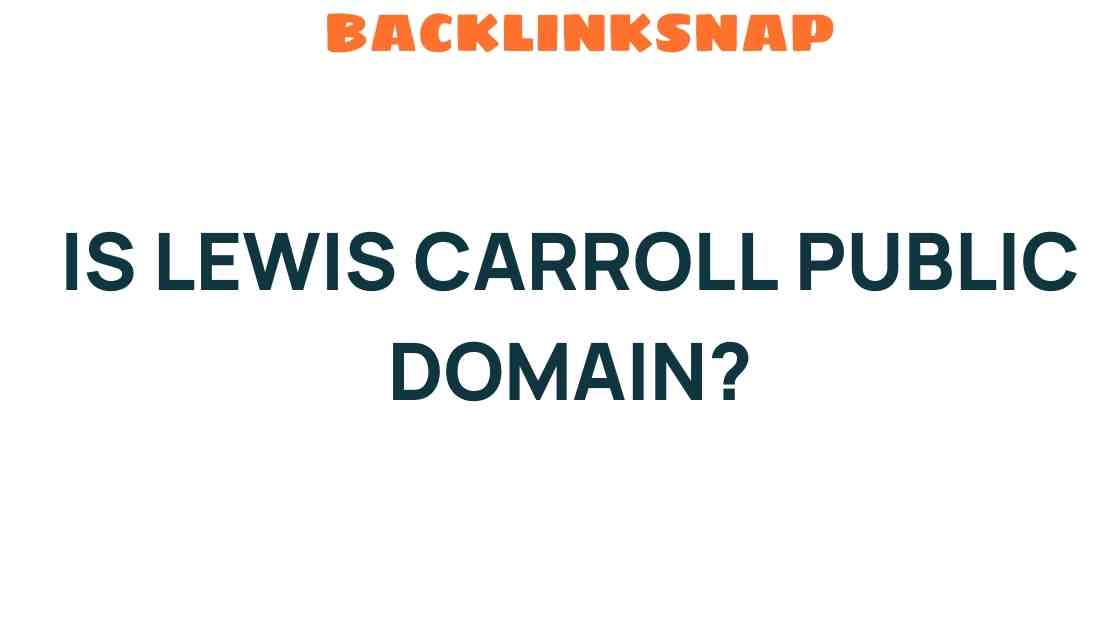Is Lewis Carroll Public Domain? Unraveling the Literary Mystery
When we delve into the realm of classic literature, one name that often stands out is Lewis Carroll. Renowned for his whimsical and imaginative works, particularly Alice’s Adventures in Wonderland and the poem Jabberwocky, Carroll’s contributions to Victorian literature have captivated readers for generations. But the question arises: is Lewis Carroll public domain? Understanding the implications of public domain status is crucial for authors, educators, and enthusiasts of literary works. In this article, we’ll explore the copyright status of Lewis Carroll’s works and their availability for public use, shedding light on an intricate web of intellectual property rights.
Understanding Public Domain
Before answering whether Lewis Carroll is public domain, it’s essential to grasp what public domain means. Works enter the public domain when they are no longer protected by copyright, allowing anyone to use, share, and adapt them without seeking permission or paying royalties. This status can result from the expiration of copyright terms, abandonment of rights, or specific legal exemptions.
Copyright laws vary by country, but generally, they protect a creator’s work for a limited time. In many jurisdictions, this duration is the life of the author plus a specified number of years, typically 70. Once this period lapses, the work becomes public domain.
Lewis Carroll’s Copyright Status
Lewis Carroll, born Charles Lutwidge Dodgson in 1832, passed away in 1898. Given his death date, it’s vital to consider how copyright laws have evolved since then. In most countries, works published before 1923 are now in the public domain. Since both Alice’s Adventures in Wonderland (1865) and Through the Looking-Glass (1871) fall well before this cutoff, they are indeed public domain works.
Furthermore, Carroll’s famous poem, Jabberwocky, published in Through the Looking-Glass, also enjoys the same public domain status. This means that anyone can freely use these texts for their projects, adaptations, or literary explorations without any legal ramifications.
The Impact of Public Domain on Literary Works
Having access to public domain works like those of Lewis Carroll has profound implications for creativity and education. Here are several key benefits:
- Accessibility: Public domain texts are available to everyone, enabling readers, students, and educators to access classic literature without cost.
- Adaptation Opportunities: Artists and writers can freely adapt these works, leading to a resurgence of creativity. This has given rise to new interpretations of Carroll’s characters and stories in various media.
- Scholarly Research: Researchers and scholars can analyze and explore these texts without the constraints of copyright, facilitating deeper literary analysis.
For instance, numerous adaptations of Alice in Wonderland have emerged, ranging from films and stage productions to graphic novels and video games. The freedom to reinterpret Carroll’s works allows for innovative storytelling that keeps the original spirit alive while appealing to modern audiences.
Exploring the Legacy of Lewis Carroll
Lewis Carroll’s legacy extends far beyond his texts. His unique style, characterized by playful language, absurdity, and a keen understanding of childhood, has influenced countless authors and artists. The surrealism found in his works paved the way for future literary movements, including modernism and postmodernism. Timeless characters like the Cheshire Cat, the Mad Hatter, and the Queen of Hearts continue to resonate with readers of all ages.
Moreover, Carroll’s penchant for wordplay and logic puzzles, as evident in Jabberwocky, has inspired educational approaches that emphasize creative thinking and problem-solving. His works are frequently integrated into curricula to promote literary analysis, critical thinking, and imagination.
FAQs about Lewis Carroll and Public Domain
1. What does it mean for a work to be in the public domain?
A work in the public domain is no longer under copyright protection, allowing anyone to use, share, or adapt it freely.
2. Are all of Lewis Carroll’s works public domain?
Yes, all of Lewis Carroll’s major works, including Alice’s Adventures in Wonderland and Through the Looking-Glass, are in the public domain.
3. How can I access Lewis Carroll’s public domain works?
Many online platforms, such as Project Gutenberg, offer free access to public domain texts, including those by Lewis Carroll.
4. Can I adapt Lewis Carroll’s works for commercial purposes?
Yes, since his works are in the public domain, you can adapt them for commercial purposes without needing permission.
5. Are there any restrictions on using public domain works?
Public domain works can be used freely, but you must ensure that any adaptations do not infringe on other copyrights, such as illustrations or adaptations that are still under copyright.
6. How has Lewis Carroll influenced modern literature?
Carroll’s inventive use of language and themes of absurdity have inspired many modern writers and artists, contributing to genres like fantasy and surrealism.
Conclusion
In conclusion, Lewis Carroll’s works are indeed public domain, allowing readers and creators to explore his literary genius without restrictions. His contributions to Victorian literature remain a vibrant part of cultural heritage, inspiring countless adaptations and interpretations. The public domain status of Carroll’s works not only preserves their accessibility for future generations but also encourages creativity and innovation in the arts. Whether you’re a seasoned scholar or a curious reader, diving into the whimsical worlds crafted by Lewis Carroll is a delightful journey waiting to be undertaken. For further exploration of public domain literature, consider visiting Project Gutenberg for a treasure trove of classic works.
This article is in the category Digital Marketing and created by BacklinkSnap Team




